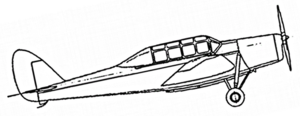de Havilland Swallow Moth
| DH.81 Swallow Moth | |
|---|---|
 | |
| Role | sports aircraft |
| National origin | United Kingdom |
| Manufacturer | de Havilland Aircraft Co. Ltd |
| First flight | 21 August 1931 |
| Retired | 3 February 1932 |
| Number built | 1 |
|
| |
The de Havilland DH.81 Swallow Moth was aimed at the low-cost sporting aircraft market during the Great Depression. It was a single-engined two-seat low-wing monoplane; only one was built.
Development
The DH. 81 Swallow Moth[1] was a low-wing cantilever monoplane. This arrangement and its plywood-covered fuselage and closely cowled 80 hp (60 kW) inline Gipsy IV engine gave it a very clean aerodynamic look. The wings carried ailerons that were horn-balanced at the wingtips and the empennage was of characteristic de Havilland form, with a balanced rudder. There was separate tandem seating for two, initially open, but later enclosed with a one-piece hinged cabin top. With this enclosure the aircraft was called the DH.81A and the top speed increased by 12 mph (19 km/h). The main undercarriage was simple, the legs reaching to mid-fuselage in front of the leading edge of the wing, with bracing struts fore and aft to the keel; the later Leopard Moth used a similar arrangement. A small tailskid completed the undercarriage.[1]
The Swallow Moth was first flown by Geoffrey de Havilland on 21 August 1931.[2] Some alteration to the fin followed and the flight testing continued until February 1932. During this time the class B marking E-7 was allocated, but the Swallow Moth never reached the civil register. Its design influenced later de Havilland aircraft, particularly the 1938 Moth Minor.[3]
Specifications
Data from Jackson 1978, pp. 302
General characteristics
- Crew: one
- Capacity: one
- Length: 23 ft 6 in (7.16 m)
- Wingspan: 35 ft 6 in (10.82 m)
- Height: 8 ft 4 in (2.56 m)
- Wing area: 149 ft2 (13.85 m2)
- Gross weight: 1,330 lb (603 kg)
- Powerplant: 1 × de Havilland Gipsy IV four-cylinder inverted inline air-cooled engine, 80 hp (60 kW)
Performance
- Maximum speed: 117 mph (188 km/h)
References
| Wikimedia Commons has media related to De Havilland DH.81. |
Notes
Bibliography
- Jackson, A.J. (1978). de Havilland Aircraft since 1909. London: Putnam Publishing. ISBN 0-370-30022-X.